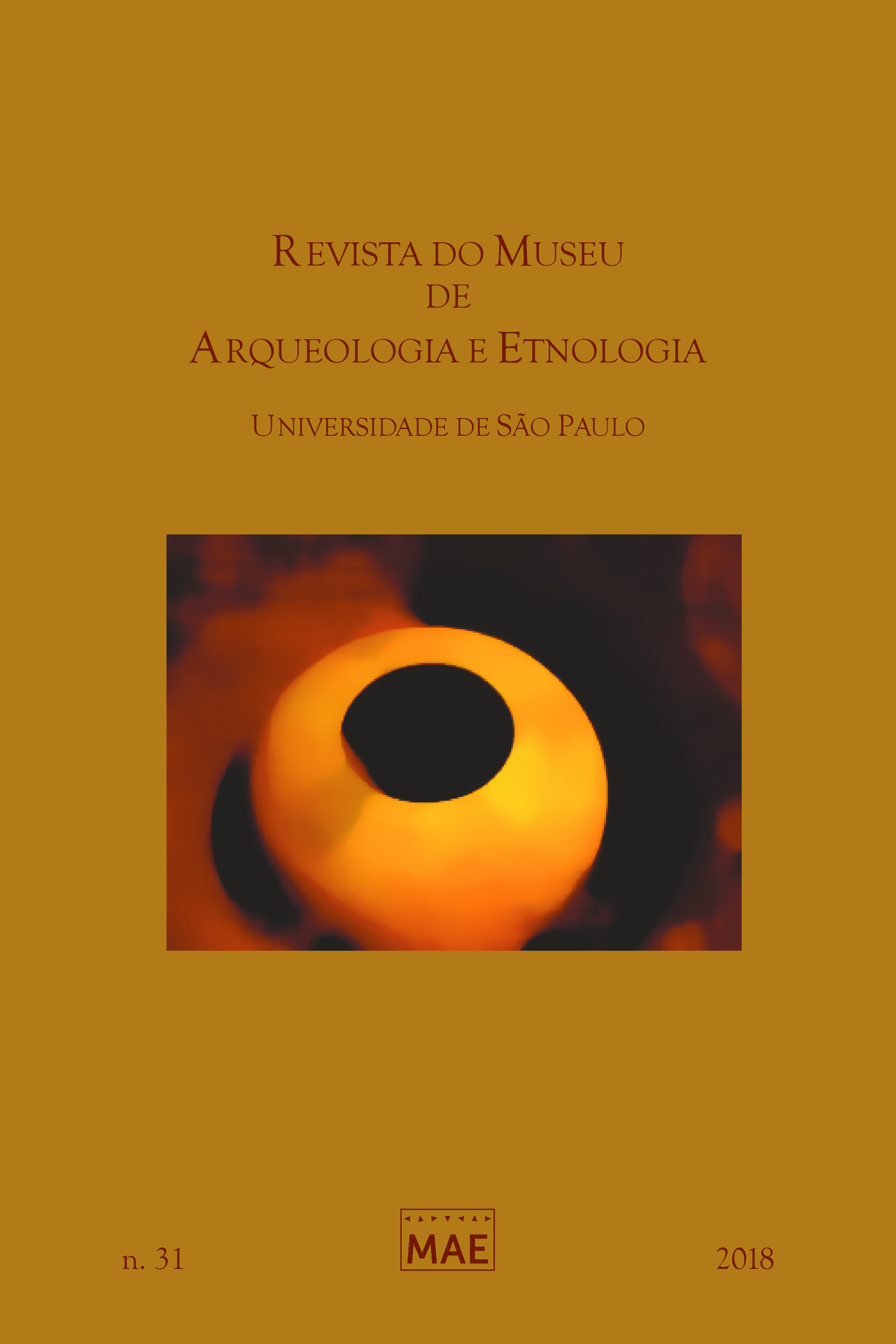The Khóra and elsewhere: a note about eskhatiá in the Electra of Euripides
DOI:
https://doi.org/10.11606/issn.2448-1750.revmae.2018.161245Keywords:
Ancient Greek theater, Euripidean tragedy, Electra, Khóra, eskhatiáAbstract
Euripides (485 b.C- 406 b.C) took to the stages of the theater of Athens a su generis interpretation of the Electra mith around 415 BC. The poet altered with ingenuity all the narrative concerning the rural space and added a major character in the progression of the play, the old servent, preceptor of Agamemnon. Expelled from the asty by the tyrant Egisto, the old servent lives in the border of the city and does agrarian activities in his property. Our goal is to analyze the small farm of the loyal servent of the Atrida family, located in the eschatia. Unlike some modern studies that see this surrounding lands as unproductive or destined exclusively to the minor activities, like hunting and wood extraction, or almost isolated from the polis, we resemble with studies that see theeschatia as an integrated space of the polis, a complex, plural and a lot of times productive space
Downloads
References
Aristófanes. 1992. The acharnians, the knights, the clouds, the wasps. Tradução Benjamin Bickley Rogers.Harvard University, Cambridge; London, 1992.
Aristóteles. 1960. Politique. Tradução Jean Aubonnet. Les Belles Lettres, Paris.
Bernand, A. 1985. La carte du tragique: la géographie dans la tragédie grecque. Centre National de la Recherche Scientifique, Paris.
Bignotto, N. 1998. O tirano e a cidade. Discurso, São Paulo.
Buxton, R. 1992. Imaginary Greek mountains. The Journal of Hellenic Studies, 112: 1-15.
Chevitarese, A.L. 1998. Parentes, amigos e assalariados livres na agricultura Ática no período clássico. Phoînix 4: 47-58.
Coutsinas, N. 2011. Territoire et frontières dês cites crétoises hellénistiques: l’exemple de Lato. In: Kourtessi-Philippakis, G.; Treuil, R. (Orgs.). Archéologie du territoire, de l’Égée au Sahara. Université Paris 1 Panthéon-Sorbonne, Paris, Cahiers Archéologiques de Paris 1, n. 2, 245-255.
Cropp, M. J. 1988. Euripides: Electra. Warminster, Wiltshire.
Daverio-Rocchi, G. 1988. Frontiera e confini nella Grecia Antica. L’Erma di Bretschneider, Roma.
Diggle, J. 1981. Euripidis Fabulae. OxfordUniversity, Oxford, v. II.
Ellinger, P.1981. Ártemis. In:Bonnefoy, Y. (Org.).Dictionnaire des mythologies.Flamarion, Paris, 70-71.
Ésquilo.2008. Oresteia: Agamenon, Coéforas, Eumênides. Tradução Manuel de Oliveira Pulquério.Setenta, Lisboa.
Florenzano, B.B.2014.Defining the Greek polis: the role of borders in the articulation of space. Labeca/MAE-USP, São Paulo.
Giangiulio, M. 2001. L’eschatia prospective critiche su reppresentazione Antiche e Modelli moderni. In:Atti del 40 Convegno Magna Grécia. Istituto per la Storia e l’Archeologia della Magna Grecia, Taranto, 2001, 333-361.
Gras, M. 1998. O Mediterrâneo arcaico. Tradução Telma Costa. Teorema, Lisboa.
Homero. 2010. Odisseia. Tradução Frederico Lourenço. Cotovia,Lisboa.
Kormikiari, M.C.N. et al. 2011. O estudo das fronteiras no mundo antigo: o caso grego. In:Aldrovandi, C.E.V.; Kormikiari, M.C.N.; Hirata, E.F.V.Estudos sobre o espaço na Antiguidade.Edusp, São Paulo, 125-156.
Laboratório de Estudos sobre a Cidade Antiga – Labeca. 2009. Cidade e território na Grécia antiga: organização do espaço e sociedade (projeto de pesquisa). Labeca. Disponível em: <https://goo.gl/W8YH2Q>. Acesso em: 19/2/2018.
Laboratório de Estudos sobre a Cidade Antiga – Labeca. 2010. A organização da khóra: a cidade grega diante da sua hinterlândia (projeto de pesquisa). Labeca. Disponível em: <https://goo.gl/qgLz3H>. Acesso em: 9/2/2018.
Laboratório de Estudos sobre a Cidade Antiga – Labeca. 2013. Glossário. Labeca. Disponível em: <https://goo.gl/QgwjSz>. Acesso em: 14/2/2018.
Lewis, D.M. 2008. Mainland Greece, 479-451 B.C. In: Lewis, D.M. et al. The fith centuty B.C. Cambrigde University, Cambridge, Cambridge Ancient History, v. 5, 96-120.
Lloyd, M. 2012. Space in Euripides. In: Jong, I.J.F. (Ed.). Space in ancient Greek literature. Studies in Ancient Greek Narratives.Brill, Leiden, Studies in Ancient Greek Narratives, 341-357.
Muggia,A. 1997. Le premesse della ricerca. In:Muggia, A. L’ area di rispetto nelle colonie magno-greche e siceliote. Sellerio, Palermo, 13-55.
Polinskaya, I. 2006. Lack of boundaries, absence of oppositions: the city-countryside continuum of a Greek Pantheon. In:Rosen, R.M.; Sluiter, I. City, countryside, and the spatial organization of value in classical antiquity. Brill, Leiden, 61-92.
Ribeiro, M.C.L.2015. Representações da cidade na tragédia grega:entre o espaço construído e o espaço concebido.Tese de doutorado. São Paulo: FFLCH/USP.
Ribeiro, M.C.L. 2016. Electra e Orestes: os efebos euripidianos na khóra de Argos. Classica 29(1): 7-27.
Robert, L. 1960. Recherches épigraphiques. Revue des Études Anciennes62(3-4): 276-361.
Romilly, J. 1986. La modernité d’Euripide. Université de France, Paris.
Rousset, D. 1994. Les frontières des cités grecques. Premières réflexions à partir du recueil des documents épigraphiques. Cahiers du Centre Gustave Glotz 5: 97-126.
Roy, J. 1996. The countryside in classical Greek drama, and isolated farms in Dramatic Landscape.In: Shipley, G.; Salmon, J. Human landscapes in classical antiquity. Routledge, London, Leicester-Nottingham studies in ancient society, v. 6, 98-118.
Sacconi, K.A. 2012. Electra de Eurípides: estudo e tradução. Dissertação de mestrado. São Paulo: USP.
Tacla, A.B. et al. 2011. A natureza da cidade portuária e a relação portos-portas em contextos helênicos.In:Aldrovandi, C.E.V.; Kormikiari, M.C.N.; Hirata, E. F. V. Estudos sobre o espaço na Antiguidade. Edusp, São Paulo, 157-195.
Sófocles. 2008. Filoctetes. Tradução, introdução e notas Fernando Brandão dos Santos. Odysseus, São Paulo.
Sófocles. 2009. Electra(s): Sófocles/Eurípides.Tradução Trajano Vieira. Ateliê, São Paulo.
Vernant, J. 2014. Tensões e ambiguidades na tragédia grega. In: Vernant, J; Vidal-Naquet, P. Mito e tragédia na Grécia antiga. Tradução Anna Lia A. de Almeida. Perspectiva, São Paulo, 7-24.
Vidal-Naquet, P. 1981. Le chasseur noir: formes de pensée et formes de société dans le monde grec. Maspero, Paris.
Downloads
Published
Issue
Section
License
Copyright (c) 2018 Márcia Cristina Lacerda Ribeiro

This work is licensed under a Creative Commons Attribution-NonCommercial-NoDerivatives 4.0 International License.













